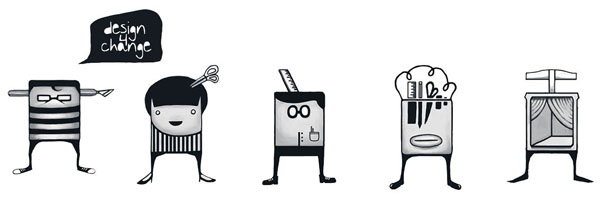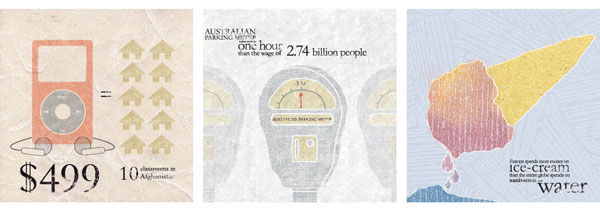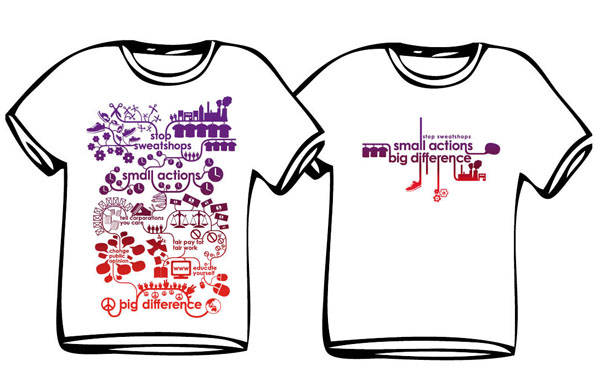Oxfam’s Design4Change project
The Oxfam’s Design4Change project for me was the moment of ‘revolution’ that Sean Dorrance Kelly talks about in the first lecture of the Later Heiddeger lecture series. This was the moment where my central understandings around the social impact of design were challenged by the mounting evidence that stacked up in the margins.
Up until this point in my career, I’d had a range of experiences that had helped me formulate my understanding of the social impact of design. I had setup my own design agency, ilk media, through which I had cultivated my interest in working for the ‘right’ clients and printing on the ‘right’ kind of stock and so on. I’d setup a social enterprise that enabled me to expand on this basic understanding and appreciate the value of community contribution. These experiences combined, enabled me to reflect back onto past work and analyse them with a new perspective. The Sri Lanka experience for example, shifted my focus onto the power of co-design and the value of community contribution. My understanding was becoming more complex.

By 2007, when the Oxfam role showed up, I felt very confident about my understanding of the social impact of design and my role in it. When I saw Oxfam Australia’s Youth Engagement Program (YEP) Coordinator position being advertised, it seemed like the perfect opportunity to combine my skills and interests. This role, I thought, would enabled me to be the social designer that I wanted to be. Within this newly established role, I was to design and then implement a national youth program for Oxfam Australia. The story about what the role entailed and what we achieved is far too big for this blog entry. The short version of it is that it was an exciting opportunity within an amazing organisation that was willing to try new things. What I will focus on here is one element of the program – the Design4Change project.

Design4Change branding designed by UTS students as part of the Community Project subject
Design4Change was one of the first pilot projects I set up in my new role at Oxfam. It was an obvious direction to head in considering my previous experiences and connections. The idea behind the project was simple. When dealing with issues of global poverty and injustice, it isn’t enough to work directly with communities that are impacted by poverty. You must also influence ‘actors’ in the equation – those who are doing the impacting. Our government and big corporations can, and should play a pivotal role in this area. And to convince them to take action, we need the support of the broader community. In this context, Design is a powerful profession that can play an influential role. Design4Change responded to this call by collaborating with design students through existing curriculum. Oxfam provided the context and the students provided the creative response. Through this collaboration we aimed to support the students to understand their impact as designers and hopefully influence them to contribute to positive social change in the future. We developed the project over three years of iterative pilotting, where the nature of collaboration shifted with our learning.
Through the evaluation process, we learned that the students best responded to project briefs that were accompanied by rich immersive experiences. On a project focusing on Labour Rights, we organised for the students to meet with a home worker based in Sydney. On a climate change project, we introduced the students to community members from the island nation of Tuvalu who spoke about the impact of climate change on their community. These meetings were supported by Oxfam’s community development workers who provided context and further support on the thematic areas.
The project seemed to be going well. We expanded the project over the years and partnered with UTS, Billy Blue College of Design and UWS. The students produced strong design responses – some of wich we moved into production. Two examples are below:

Education cards produced by UTS Community Project students

T-shirt design produced by UTS Community Project students
We were pretty excited by this project. The evaluations were showing that the students enjoyed the projects and they valued the experience. They seemed to get a lot out of it. And from our perspective, the project was a success as the students’ understanding of the social issues shifted as a result of the project.
The limitation of the project started to surface when we started asking deeper questions. Did the students believe that the project impacted them professionally? Many told us that this was their first experience of working with a real client and they valued that. They enjoyed the immersive experiences and felt impacted by them. I started to question the project when a student told me that personally they got a lot out of it – but professionally, they weren’t interested in working for a charity so they didn’t see any benefits there. Further analysing the evaluation responses, and from the anecdotal conversations, a pattern started to emerge. The students had a narrow view of how they could professionally contribute to social change. They believed that to have a positive impact, they had to either do pro-bono work, print on recycled paper or work for a charity. If they didn’t fit into these categories – then being ‘social’ wasn’t for them. It was a shock to discover that as a community based organisation who was acting as a client, and in effect asking students to do pro-bono work, we were reenforcing this misconception.
In the following phase of the project, just before I left the organisation, I tried to counter this effect through introducing a guest speaker series. We brought in speakers from the design agencies Digital Eskimo and Republic of Everyone. By showcasing their work, we wanted to show that you didn’t have to work for a charity to be socially considerate. We had a good response to this strategy. Nonetheless, it made me realise that the problem is much bigger than I had realised and headed into a PhD to explore it further.
The Design4Change project still moves forward, facing the many challenges ahead.
Do you know any projects that attempt to broaden design students’ understanding of their social impact?
Leave a Reply